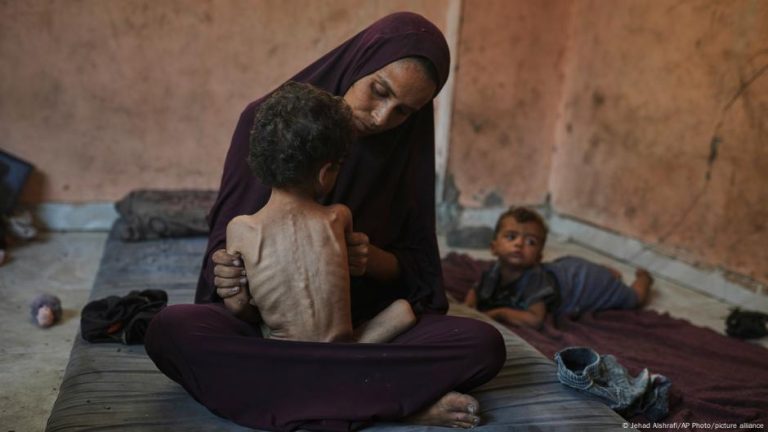Gaza’s Humanitarian Crisis: A Stark Contrast in Narratives
The escalating humanitarian crisis in Gaza has become a battleground of conflicting narratives. While Israeli Prime Minister Benjamin Netanyahu denies any policy of starvation in the enclave, a chorus of voices from aid agencies, international organizations, and eyewitnesses paints a grim picture of widespread hunger, particularly in the northern regions. This stark contrast highlights the deep divide in understanding the reality on the ground, raising critical questions about the accuracy and motivations behind the information presented by both sides.
The Integrated Food Security Phase Classification (IPC), a respected global hunger monitor, has issued dire warnings, stating that famine thresholds have been breached in several areas of Gaza, including Gaza City. The World Health Organization’s alarming statistics further underscore the severity of the crisis, with a sharp increase in malnutrition-related deaths recorded in July alone. These numbers include a significant proportion of children under five, a particularly vulnerable demographic in humanitarian crises. Adding to the growing concern, aid workers in Gaza report experiencing hunger themselves, and the Health Ministry has documented dozens of starvation-related deaths in recent weeks. This confluence of evidence challenges the narrative presented by Israeli officials.
Israeli officials, including Foreign Ministry spokesperson Oren Marmorstein, have countered the alarming reports by dismissing the figures presented by Gaza’s health authorities and UN bodies as exaggerated and unreliable. They question the credibility of the data, attributing it, in part, to Hamas, a group designated as a terrorist organization by Israel and several other nations. However, a new independent study contradicts the Israeli narrative, suggesting that the existing figures may, in fact, underestimate the true extent of the crisis. This divergence in interpretation further muddies the waters and underscores the urgency of independent verification of the situation in Gaza.
The debate extends beyond official circles, spilling onto social media platforms where a concerted effort to downplay the crisis is underway. Numerous online personalities and accounts challenge the reports of widespread hunger, either minimizing the severity of the situation or outright labeling them as fabrications. This online campaign echoes the official Israeli line, raising concerns about a coordinated effort to shape public perception of the humanitarian crisis. Israel’s complete blockade on food, fuel, and other essential supplies, imposed in March, starkly contradicts claims of adequate provisions. Further fueling the controversy are statements by Israeli politicians, including Finance Minister Bezalel Smotrich, who suggested the potential “moral justification” of letting two million Gazan civilians starve. Such pronouncements add a chilling dimension to the ongoing debate.
The battle over narratives has also reached the visual realm, focusing on images of emaciated children circulating in the media. While several international outlets featured these images to highlight the humanitarian crisis, pro-Israel commentators and the Israeli Foreign Ministry countered by claiming the photographs were misleadingly used to defame Israel. They pointed to a case involving a child with a rare genetic muscular disorder, arguing that the omission of this detail constituted a deliberate attempt to manipulate public opinion. However, reports from credible news organizations, including CNN and The New York Times, acknowledged the child’s pre-existing condition while simultaneously confirming his suffering from malnutrition exacerbated by the ongoing crisis. This incident underscores the sensitivity and complexity of using images in conflict zones, emphasizing the importance of providing complete context while acknowledging the broader humanitarian situation.
Medical experts consulted by DW Fact Check emphasized that a pre-existing condition does not preclude malnutrition. Attributing emaciation solely to genetic disorders overlooks the devastating impact of prolonged nutritional deficiency. The focus on isolated cases, critics argue, serves as a diversionary tactic to distract from the overwhelming evidence of widespread hunger. The online campaign discrediting images of suffering children has taken on a life of its own, with near-identical posts circulating across various platforms. This organized effort raises concerns about a deliberate disinformation campaign aimed at obscuring the true extent of the humanitarian crisis.
The controversy extends beyond images of suffering children to encompass depictions of food availability in Gaza. A video showing a seemingly well-stocked vegetable stall in a Gaza market was circulated as evidence against the claims of famine. However, the journalist who filmed the video clarified that the footage did not represent the overall food security situation. He highlighted the prohibitive cost of these items for the majority of Gazans, and the scarcity of essential staples such as meat, milk, rice, and eggs. This incident illustrates the danger of using isolated examples to draw sweeping conclusions about a complex humanitarian crisis. While recent increases in aid deliveries have offered some respite, their impact remains limited by logistical challenges, diversion of supplies, and the ongoing economic hardships faced by Gazan families. The lack of consistent oversight further complicates the delivery and distribution of aid, leaving vulnerabilities for misuse and exploitation. Accusations of aid theft by Hamas have been countered by reports suggesting sporadic incidents rather than systematic looting. The ongoing conflict and blockade continue to hinder the delivery of vital aid, exacerbating the suffering of the civilian population and underscoring the urgent need for a sustainable solution to the humanitarian crisis.


